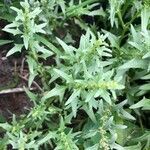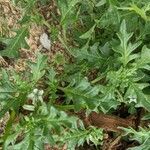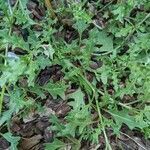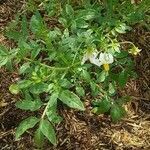Sprawling annual herb, green, sparsely pubescent with simple hairs; stems to 1 m long, sometimes rooting at nodes; prickles absent. Leaves ovate or elliptic; lamina 2-4 cm long, 1-2.5 cm wide, concolorous, shallowly lobed or dentate to deeply lobed; margin recurved and thickened; petiole 5-10 mm long. Inflorescence short, 1-3-flowered, with small terminal leaflet; peduncle 10-30 mm long; pedicels 3-5 mm long. Calyx 3-5 mm long; lobes lanceolate to narrowly triangular, 1.5-2 mm long, slightly larger and becoming reflexed in fruit. Corolla stellate, 5-6 mm diam., white or rarely pale lavender. Anthers 2.5 mm long. Berry globular, 8-12 mm diam., whitish-green, marbled. Seeds 1-2 mm long, light brownish-yellow. Stone-cell granules c. 1 mm diam.
Annual, suffrutescent herb, spreading, unarmed, hairs simple, multicelled, scattered. Stems up to 1 m long, sometimes rooting at nodes. Leaves up to 40 x 25 mm, outline ovate or elliptic, pinnatisect, margins ± recurved, thickened; petioles up to 10 mm long. Inflorescence short, subumbellate, 1-3-flowered; peduncle 10-30 mm long; pedicels 3-5 mm long. Calyx 5 mm in diam., larger in fruit, lobes ± lanceolate, 3-5 mm long. Corolla stellate, 5-6 mm in diam., white, pale lavender. Flowering time Jan.-Mar. Fruit globose, up to 15 mm in diam., whitish green marbled; stone grains many, spherical, 1 mm in diam. Seeds many, ovoid, flattened, reticulate, 1-2 mm long, light brown-yellow.
Foetid annual, ± prostrate, branched from the base, 1–6 dm, short-hairy or eventually glabrate; lvs short-petiolate, the blade 2–5 × 1–3 cm, evidently pinnatilobate, the rachis seldom wider than the length of the lobes; cal accrescent, the tube short, the rather narrow lobes to 6 mm in fr; fr globose, greenish, 9–14 mm; 2n=24; otherwise like nos. 2 [Solanum nigrum L.] and 3 [Solanum sarrachoides Sendtn.]. Native to w. U.S., occasionally intr. as a weed in our range.
Perennial herb. Stems annual, spreading or decumbent. Spines absent. Leaves shortly petiolate; blade narrowly ovate, margins pinnatipartite, lobes linear. Flowers: in 2-or 3-flowered clusters; corolla ± 10 mm wide, white, occasionally purple-tinged. Fruit an orange-red berry, ± 10 mm in diameter.
An annual plant. It is low and spreading. It forms mats. The leaves are alternate and simple. They are deeply lobed. They are 2.5-8 cm long. The flowers is white and 5-10 mm across. They are borne in clusters of 3. The fruit is a small, round, green berry.




